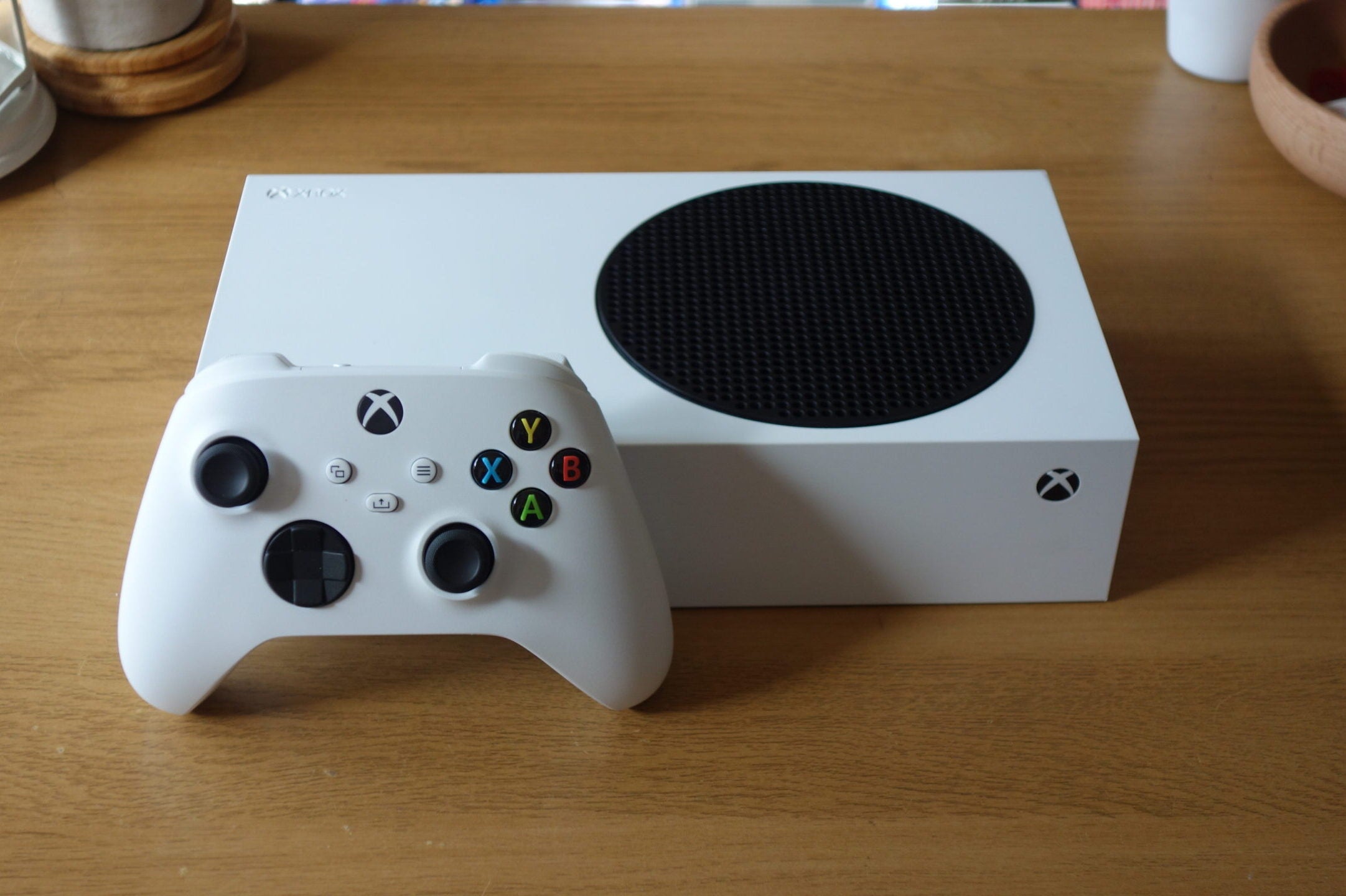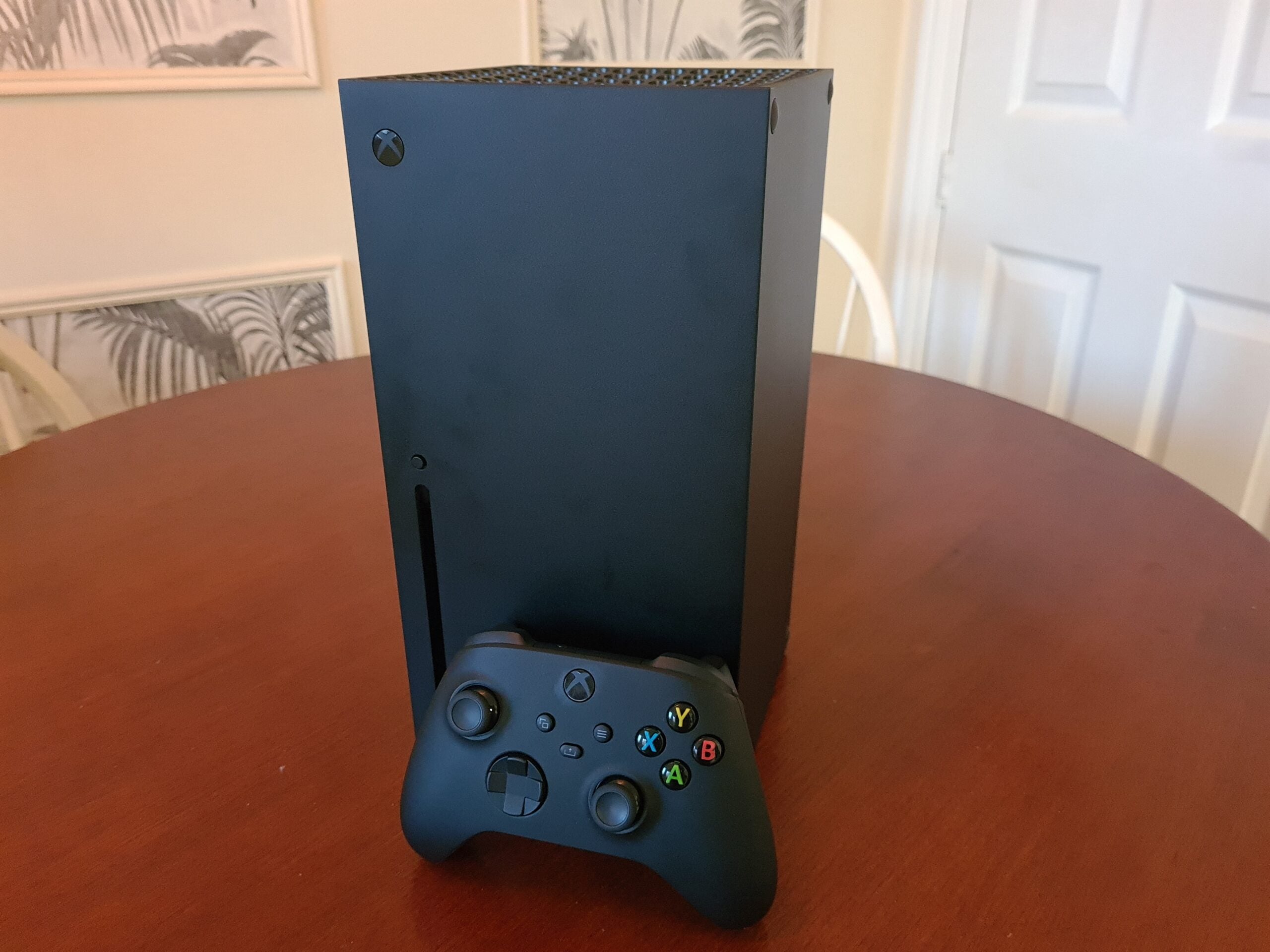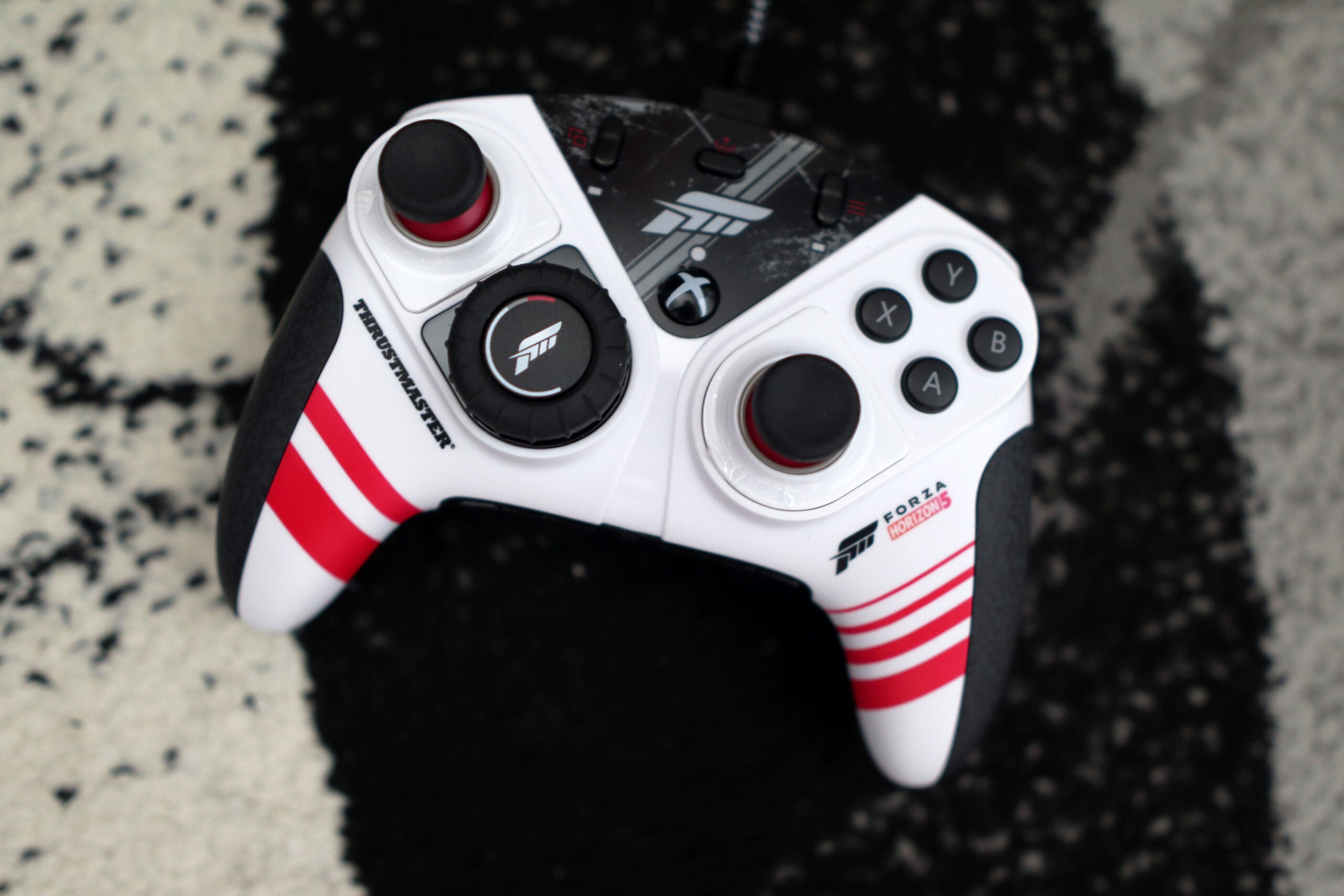Super Pocket Review
A delightfully cheap classic pocket handheld.





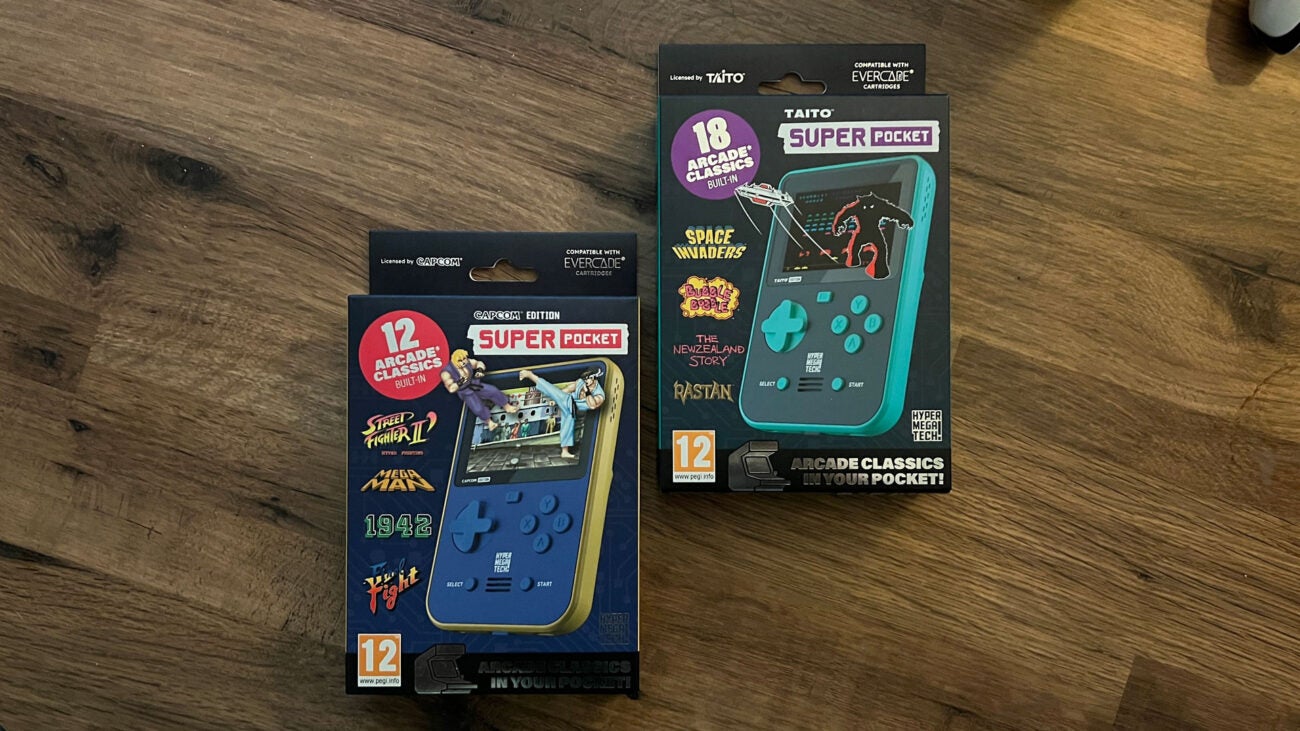

Verdict
At just £50 for heaps of arcade classics, the Super Pocket is a terrific gift or payday treat. With support for the wonderfully cheap Evercade cartridge library, it’s a great classic handheld that is set to give and give, too.
Pros
- Additional games via Evercade library
- Modern features like save, load, difficulty, and screen effects
- Sturdy build and satisfying buttons
- Amazing value
Cons
- Battery could last longer
- No brightness control
Key Features
- Built-in titlesThough they’re exclusive to their respective systems, the games included with each of the two Super Pocket devices are genre-defining classics from Taito and Capcom.
- Rock-bottom priceAt £50 a pop, these are wonderful handheld games consoles with lots of replay value and solid durability.
- Affordable expansionWith compatibility for Evercade cartridges ranged from £15-20, over 500 games are available for those who want the Super Pocket to be the start of a larger collection.
Introduction
The Super Pocket line of handhelds from Hyper Mega Tech may look like the run-of-the-mill retro game knockoffs you used to see on your jollies all around the little markets, but there’s something truly special going on here.
Properly licensed by Blaze Entertainment and built with evidenced care for the core arcade experience, they’re incredibly reliable and faithful ways to turn back the clock – just for a little bit.
In the face of a growing market of handheld PCs and premium machines that look to give new purpose to your dusty old collection, these comparatively bargain bin affairs are a breath of fresh air. A system you can tuck away in a drawer or let slide down the back of the couch without concern.
Design
- Two different designs (with different games)
- Ultra-portable size
- Satisfying buttons and handy ports
The Super Pocket comes in two different designs: a fun-exuding blue and yellow shell, or a sort of teal affair.
The differences don’t stop there, though. For better or worse, the colour schemes relate to the games included, Capcom classics for the former, and Taito titles for the latter – the colours of the shell being the signature stylings of each famous game maker, in case it wasn’t obvious.
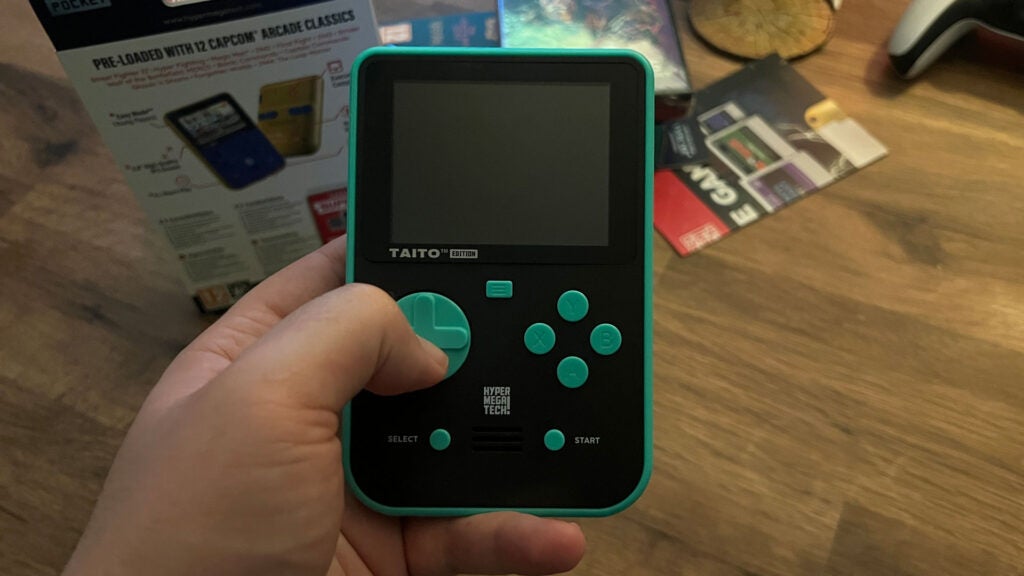
The shape of the shell itself stays the same regardless of the colour wave. It’s a perfectly-grippable rounded rectangle of a device, being a little bit chunkier than the Gameboy Pocket but nowhere near as blocky and encumbering as the original Gameboy. Though it’s an entirely plastic chassis, it feels strong, sturdy, and ready to take a beating.
There’s a little lip on the back for your index fingers to rest (and pull) for the stressful moments that inevitably follow playing any penny-pinching arcade game from the 80s and 90s, and four additional buttons just below. These are quite tricky to press in the moment, but those moments rarely (if ever) arrive with the games built into either of these machines.
In all, it’s a design very reminiscent of the swathe of emulation devices being popularized on TikTok over the last couple of years.
It would have been nice to see those rear buttons jut out more like the triggers of similar devices, but the Super Pocket’s flatter approach does lead to them feeling immediately more sturdy than more squeezable efforts on the Powkiddy/Anbernic handhelds floating around the web. I’ve busted (and fixed one) up before, so I know how brittle they can be.

A single speaker between the Select and Start button serves up a surprisingly loud sound that can have the India stage of Street Fighter II waking the whole house up. Thankfully the volume rocker is positioned at the top back of the device for easy reach in the middle of the action.
Further on the front, you’ve got a spacious full-circle d-pad, slim, sturdy face buttons, and a small menu button right below the screen for quickly accessing handy system controls.
On the bottom, there’s a USB-C charging, a 3.5mm headphone jack for silencing those elephants, and a power switch that contributes to the nostalgic electrical pop of the whole thing firing up like a classic handheld. Bliss.
Display
- Bright 240p LCD panel
- Filter and aspect ratio options
- No brightness control
Each Super Pocket system uses a 2.8” IPS display. It’s small, bright, and won’t look off at odd angles.
Covered by a pane of glass embellished with the logo of whichever publisher edition you went it, it is still slim enough to likely take a fit of rage that’s honestly justified against some of the hellishly difficult offerings built in.

Through the system menu, you can change the aspect ratio between original, full-screen, and pixel-perfect in seconds. Second to that, you can add or remove scan lines of two different strengths to have any game look however you like.
The settings may not be as deep or detailed as you’ll find on some other emulation efforts, but at this price, it’s likely not gunning for absolutely perfect reproduction. Those into that level of fidelity will want something like the Analogue Pocket or a TV-bound machine like a SuperNT (if you can get your hands on one.)
For a hyper-casual retro fan like myself, it’s essentially perfect. It’s bright, and clear, and doesn’t have any immediately noticeable issues with input lag, ghosting, or any that might negatively impact the experience of someone who hasn’t analysed every frame of the game they’re playing on the original hardware.
What is surprising, however, is a lack of brightness control, which might make playing this in the dark before bed a little harsh on the eyes.
Performance and Games
- Choice of two classic game collections
- Room to expand through Evercade cartridge library
- Modern solutions to make older titles more accessible
Even from the moment you scroll through the EULA at start-up, the processor under the hood keeps everything running more smoothly than I’d have expected from something at this price.
With how tough accurate emulation can be on some of these kinds of comparatively archaic titles, there was no issue with inconsistent frames, jitter, or hitching on any of the 8+ games I tested.
Granted, I admittedly played them on easy mode, which could have had a positive performance impact with fewer enemies – yes, a major extra effort here is that there’s a system-wide difficulty setting to make stomaching the harsh retro titles a little easier – but the few I tested at their default difficulty faired just the same.
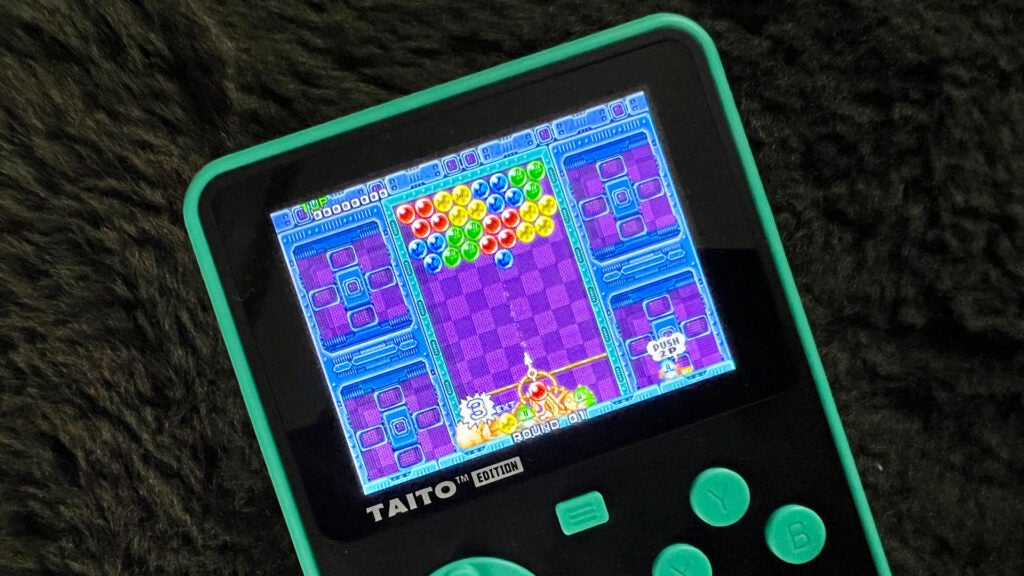
The back of the box will tell you that “Easy Mode” is great for young players, but rest assured that even that won’t make these titles a walk in the park. Nothing could. At least you can slam the Select button repeatedly to wrack up the credits needed to see it through.
There’s even a save state feature under the system menu you can use to avoid going right back to the start of a stage when you’re trying to beat the boss that might have ruined your childhood.
You technically get more built-in games with the Taito edition’s 18 over the Capcom version’s 12, but Capcom arguably has the edge with more 16-bit hits on offer. The inclusion of Street Fighter 2, Final Fight, and Mega-Man is more important for me personally than Puzzle Bobble and Bubble Bobble on the Taito, despite how much I love those adorable dragons. Rainbow Island would have been the kicker.
Despite all that, the real boon of the Super Pocket is that it’s not a one-and-done machine. The built-in games aren’t all you’ll ever get. Though you won’t be able to play the titles of one on another (they’re exclusive to their respective edition) you can expand your library massively thanks to support for the Evercade lineup of cartridges.
Costing between £15-20 a pop, there are over 40 cartridges you can slot into it, collecting over 500 classic games from publishers and machines like Team17, Taoplan, Commodore, and PCEngine that can all be played on this cheap and cheerful handheld. And yes, they make that ultra-satisfying ka-chunk sound as they go in.
Included in my review unit was the Irem Arcade 1 cartridge, featuring games like the iconic R-Type shmup, and one of the best side-scrolling beat em’ ups of the generation – Lightning Swords. It’s the first home release of the game, and the first time it’s even been available to play officially outside of the UK and Japan. Exciting stuff.
Between the familiarly frenetic fun of those titles, I took the opportunity to try the American Football game 10-Yard Fight.

Being from the UK, I had absolutely zero clue what was going on. And it was great. It did make me wish the lovingly included paper manual had more to say than just the simple controls (which can be viewed through the system menu, too), though. A little infographic highlighting the differences between the on-screen players maybe. I wasn’t expecting a full play-by-play breakdown of the sport, but something a little more robust would have been nice.
Still, it’s the kind of bewildering experience you don’t get with today’s titles. At least you’re not jamming quid after quid in there just to figure out how to dodge a skeleton king’s combo (spoilers: you probably can’t, the 80s were cruel.)
Battery
- 3-4 hour runtime
- USB-C charging
- No included power supply
A little disappointing is how much juice you’ll get out of the Super Pocket. Though I didn’t see the battery icon dip in my first hour or so quickly bouncing between games I couldn’t hope to beat, I had lost a bar when I checked back in the following day.
What that hammers home is that the 4+ hour runtime mentioned on the box is about right. And while that stands toe-to-toe with today’s popular handhelds like the Nintendo Switch and Steam Deck, it doesn’t if you consider the type of games you’re putting it through.
Sure, it’s quite a bit smaller, but it’s still noticeably lower than the 6-10+ hour life the Analogue Pocket parades, but it’s hardly got the runtime of a GameBoy on a couple of disposable cells. It’s hard to imagine pulling this out of the drawer in a few months with juice left in the tank.
Charged via USB-C, there’s no plug in the box, so you’ll likely need to repurpose the one used for your phone. If you’re giving it as a gift, keep that in mind if it’s going to a family with iPhones and basic laptops. They may not be equipped to keep it alive. And given it only supports 1amp charging, it’ll take a little while to juice back up, too. But you can play it while it does so.
Latest deals
Should you buy it?
You want a cheap, legal, and modern way to enjoy classic games
With a wonderful selection by default and easy access to the huge Evercade library, the Super Pocket is an affordable way to support and enjoy retro gaming and preservation efforts.
You want to enjoy the classics in as close to their original format
Being condensed or stretched to fit screen tech that didn’t exist when they were created, the Super Pocket will never be the more organic way to play some classic titles.
Final Thoughts
At a bargain price point, the Super Pocket is an incredible value and a wonderfully easy gift option. Support for 500+ games via the equally affordable Evercade line-up means it can be built upon for years, too.
Built like a brick and packed with features to make enjoying the era of gruellingly difficult titles easier to enjoy, it’s a handheld you can keep in a bag for bus journeys or, dare we say it, in a drawer by the lavatory. If Nintendo could advertise the Gameboy Advance as something you can play on the John, why can’t this? Just please wash your hands.
For around £200, you could get a Nintendo Switch Lite and maybe one game on a good deal. Or an Xbox Series S if you’re not interested in gaming on the go. But for a quarter of the price, you can get a Super Pocket and 12-18 gems and put the rest of the cash aside to grow your collection over time.
If you want handheld multiplayer, the Evercade EXP is regularly discounted. And for the specifically at-home experience, the Evercade VS is another option. But for the hyper-casual and ultra-portable gamer, the Super Pocket is stellar.
How we test
We tested the Super Pocket by playing a range of built-in games as well as additional Evercade cartridges. Along with testing the ergonomics, over a week, we tested the battery life and overall performance. Further, we compared its value with other options on the market.
Tested over the course of a week.
Played with built-in games and Evercade cartridge to test performance.
Tested the battery life.
FAQs
No, the Super Pocket can only access cartridges from the Evercade lineup.
There’s no official modding support for the Super Pocket.
The only way to officially add new games to the Super Pocket is through the use of physical Evercade cartidges.
No, buying both editions of the Super Pocket won’t allow you to combine the libraries together onto a single device.



